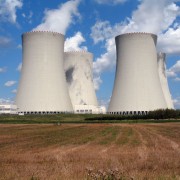Nuclear Energy
China has a major expansion of nuclear energy planned for 2020, and again for 2030. It is currently the country with the largest number of power stations in construction, and new power stations being planned. There are 13 reactors in operation and 25 more under construction. Meanwhile, preliminary work is being undertaken for dozens of nuclear projects that await government approval. China, which has contributed over 60% of the global total new builds since 2006, and in addition to building large quantities of power stations, it is also building some of the most advanced reactors in the world. The country has a target of attaining 70 gigawatts (gW) of nuclear capacity by 2020. Importantly, China is both buying up large amounts of uranium, and also expanding the capacity for domestic uranium mining, especially in Guangong. All of this is having an important impact on world uranium markets. Gansu province, in the north west of China, will also become a centre for processing nuclear waste from all over Asia, in partnership with the French company Areva.
It is widely thought that the government plans, although incredibly ambitious, are not unrealistic to achieve in China, despite the fact that they would be unrealistic in most other countries, and it will require constructing and bringing them online much faster than has occurred in other countries to date. The nuclear disaster in Fukushima had an important impact. It sparked major media debate, and a temporary government reconsideration, especially relating to safety issues, and especially in coastal areas. A moratorium on further development of nuclear power stations in coastal areas in coastal areas was put in place. Major energy think-tanks believe that the impact of this on the government’s nuclear programme will just be slowed down slightly, but not significantly altered. Policy framework is being developed and strengthened in relation to safety issues, and the budget for these areas has been increased. Projected expansion is still considered realistic within the time frame stated by government. One important consequence of Fukushima is that regional cooperation on nuclear safety between Japan, China and South Korea has strengthened in the wake of the disaster, something that is widely seen as a positive development.
The nuclear sector is being developed by central government and state owned enterprises. It has been making use of foreign technology, but Chinese nuclear industry is growing rapidly and becoming less reliant on foreign technology. With the exception of China Power Investment Corp, the country’s “Big 5” power generating companies are not yet allowed to develop nuclear power. Nuclear power development qualifications have only been granted to China National Nuclear Corp, China Guangdong Nuclear Power Group and China Power Investment Corp. China Guangdong Nuclear Power Group has the most nuclear projects currently under construction of any other company globally and is set to become the world’s largest nuclear developer over the next 10 to 15 years. The world’s major reactor manufacturers, including the French company Areva and US-based Westinghouse, are building their most advanced designs in China. Delays in other countries may even result in China becoming the first country in the world to use the EPR (European Pressurized Reactor). Importantly, Chinese companies are also actively buying up uranium supplies to fuel the reactors.
So far, environmental and other NGOs in mainland China are initiating debates on nuclear development and safety concerns. There is still little public awareness and understanding of the technology and its implications (including risks), compared to in other countries. Fukushima did generate important debate. As nuclear energy is such a central pillar of government energy plans, many people consider that it is impossible to have an anti-nuclear perspective. Instead the focus is on safety, transparency and public participation. Some NGOs have been active in trying to learn from European experiences with nuclear energy, and antinuclear movements. This has included visits to Germany and translation of German educational material on nuclear energy. There have been a very small number of small protests about nuclear energy, including a commemorative action to mark the 25th anniversary of the Chernobyl disaster, involving some students who were arrested. There are also isolated incidences of protests having delayed at least one new nuclear power station.
In Hong Kong the electricity includes supply from nuclear energy from mainland China. The Dayawan reactor, which is about 50 km from Hong Kong in mainland China, was built, by agreements between the two governments, especially to supply Hong Kong. Currently, the Hong Kong government has anticipated increased energy demand and has asked the Chinese government to expand the capacity of Dayawan. There have been protests against the Dayawan power plant, both before and after the transfer of sovereignty to China. This included about 1 million signatures that were collected and presented by Hong Kong groups to the Beijing government, calling for closing of Dayawan, in the wake of the Chernobyl accident. Greenpeace Hong Kong are advocating to reduce reliance on nuclear and are against expanding Dayawan’s capacity. They are proposing energy efficiency and wind energy (especially offshore) as alternatives. However, their position is not antinuclear per se, as they do not view this as realistic. Another coalition, No Nukes Hong Kong, is calling for an outright ban on nuclear energy, and closing down Dayawan. They express frustration with more moderate perspectives. In addition to the Dayawan plant, the Chinese government now plans for a number of new reactors to be built in the three surrounding provinces, by 2020. This will have major implications for Hong Kong.

